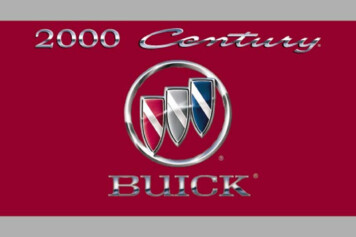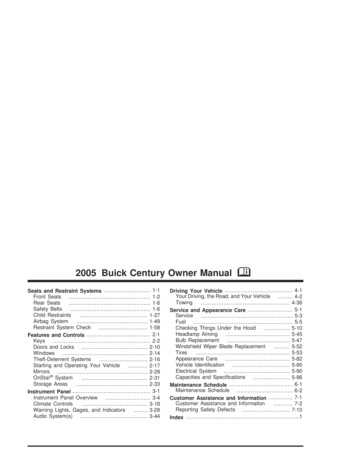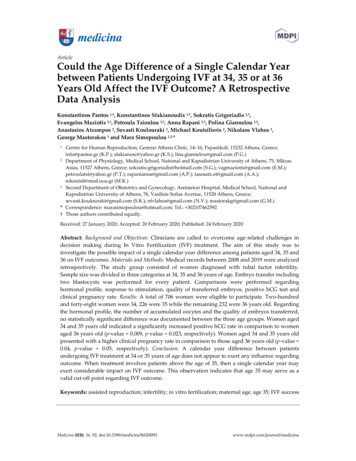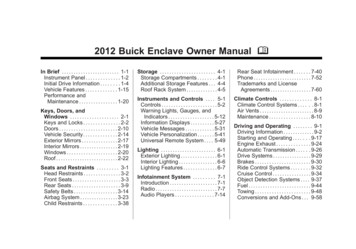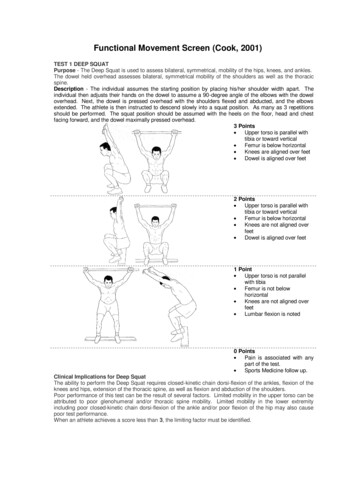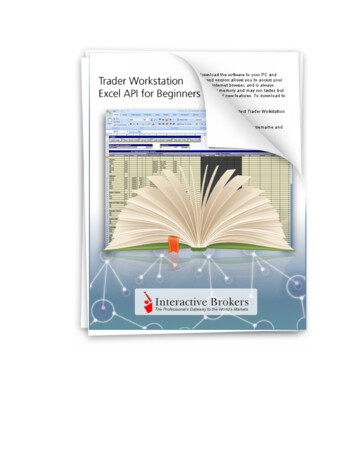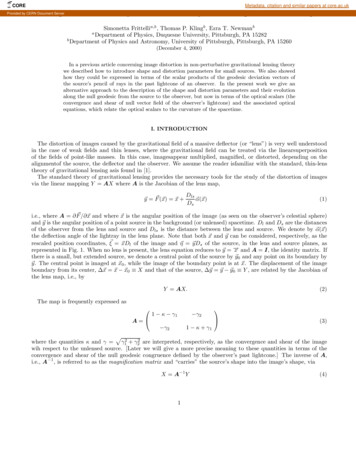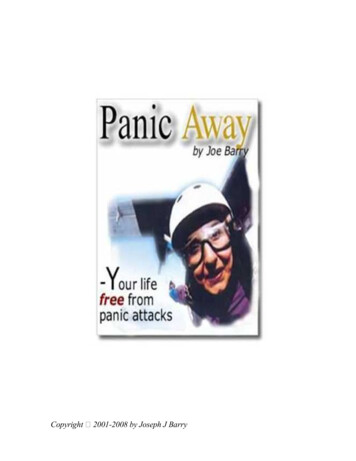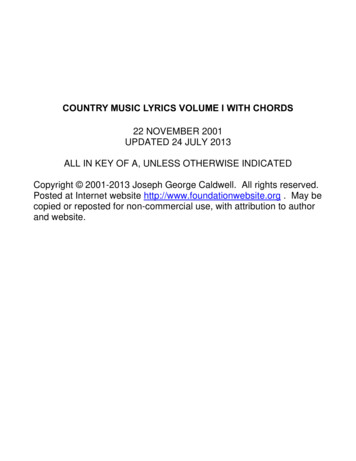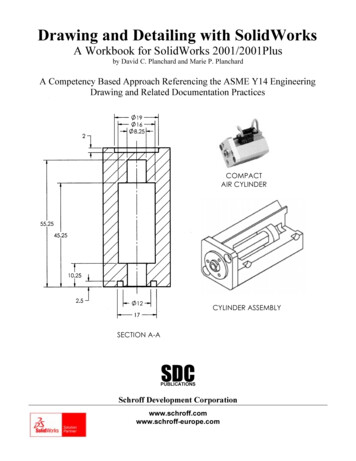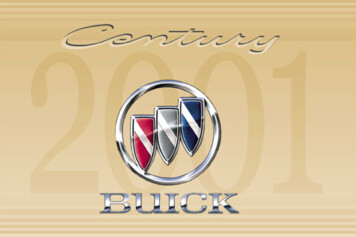
Transcription
Every2001 Centuryunder warranty isbacked with thefollowingservices:1-800-252-1112( For vehicles purchased in Canada,call 1-800-268-6800 )that provides in an emergency:CourtesyTransportationFree lockout assistanceFree dead-battery assistanceFree out-of-fuel assistanceFree flat-tire changeEmergency towing
2001 Buick CenturyOwner's ManualLitho in U.S.A.Part Number 10422380 A First Edition Copyright General Motors Corporation 2000All Rights Reservedi
Table of ContentsSeats and Restraint SystemsSection 1Seats and Seat ControlsSafety BeltsAir Bag SystemsRestraint Systems for ChildrenFeatures and ControlsSection 2iiWindowsKeys and Door LocksRemote Keyless EntryTrunk ReleaseAutomatic TransaxleParking BrakeTilt WheelTurn Signal/Multifunction LeverWindshield WipersCruise Control (If Equipped)Exterior and Interior LampsMirrorsStorage CompartmentsConvenience Net (If Equipped)Auxiliary Power ConnectionOnStar System (If Equipped)Sunroof (If Equipped)Instrument Panel, Warning Lights and Gages
Table of Contents (cont'd)Comfort Controls and Audio SystemsSection 3Heating and Air ConditioningSetting the Radio ClockRadio/Cassette Player/CD PlayerRadio Theft-Deterrent FeatureAudio Steering Wheel Controls (If Equipped)Your Driving and the RoadSection 4Defensive DrivingDrunken DrivingControl of a VehicleBrakingSteeringDriving Tips for Various Road ConditionsRecreational Vehicle TowingLoading Your VehicleTowing a TrailerProblems on the RoadSection 5Hazard Warning FlashersJump StartingTowing Your VehicleEngine OverheatingChanging a Flat TireIf You're Stuckiii
Table of Contents (cont'd)Service and Appearance CareSection 6FuelChecking Fluids and LubricantsGM Oil Life System (If Equipped)Engine Air Cleaner/FilterPassenger Compartment Air Filter (If Equipped)BrakesBulb ReplacementWindshield Wiper Blade ReplacementTires and WheelsAppearance CareElectrical System/Fuses and Circuit BreakersCapacities and SpecificationsNormal Maintenance Replacement PartsMaintenance ScheduleSection 7ivScheduled MaintenanceOwner Checks and ServicesPeriodic Maintenance InspectionsRecommended Fluids and LubricantsMaintenance Records
Table of Contents (cont'd)Customer Assistance InformationSection 8Customer Satisfaction ProcedureCustomer Assistance OfficesRoadside Assistance and Courtesy TransportationWarranty Information (See Warranty Manual)Reporting Safety Defects on page 8-9Service PublicationsIndexSection 9In the Index you will find an alphabetical listing of almost every subject in this manual.You can use it to quickly find something you want to read.Please refer to the last page of this manual for your Service Station Guidev
We support voluntarytechnician certification.GENERAL MOTORS, GM, the GM Emblem, BUICK,the BUICK Emblem and the name CENTURY areregistered trademarks of General Motors Corporation.This manual includes the latest information at the timeit was printed. We reserve the right to make changesafter that time without further notice. For vehicles firstsold in Canada, substitute the name “General Motors ofCanada Limited” for Buick Motor Division whenever itappears in this manual.Please keep this manual in your vehicle, so it will bethere if you ever need it when you’re on the road. If yousell the vehicle, please leave this manual in it so the newowner can use it.For Canadian Owners Who Prefer aFrench Language Manual:Aux propriétaires canadiens: Vous pouvez vousprocurer un exemplaire de ce guide en français chezvotre concessionaire ou au:Helm, IncorporatedP.O. Box 07130Detroit, MI 48207vi
How to Use this ManualMany people read their owner’s manual from beginningto end when they first receive their new vehicle. If youdo this, it will help you learn about the features andcontrols for your vehicle. In this manual, you’ll findthat pictures and words work together to explainthings quickly.Safety Warnings and SymbolsYou will find a number of safety cautions in this book.We use a box and the word CAUTION to tell youabout things that could hurt you if you were to ignorethe warning.CAUTION:These mean there is something that could hurtyou or other people.In the caution area, we tell you what the hazard is.Then we tell you what to do to help avoid or reduce thehazard. Please read these cautions. If you don’t, you orothers could be hurt.You will also find a circlewith a slash through it inthis book. This safetysymbol means “Don’t,”“Don’t do this” or “Don’tlet this happen.”vii
Vehicle Damage WarningsAlso, in this book you will find these notices:NOTICE:These mean there is something that coulddamage your vehicle.In the notice area, we tell you about something that candamage your vehicle. Many times, this damage wouldnot be covered by your warranty, and it could becostly. But the notice will tell you what to do to helpavoid the damage.When you read other manuals, you might seeCAUTION and NOTICE warnings in differentcolors or in different words.You’ll also see warning labels on your vehicle.They use the same words, CAUTION or NOTICE.viii
Vehicle SymbolsThese are some of the symbols you may find on your vehicle. Also see “Warning Lights and Gages” in the Index.For example,these symbolsare used on anoriginal battery:CAUTIONPOSSIBLEINJURYPROTECTEYES BYSHIELDINGCAUSTICBATTERYACID COULDCAUSEBURNSAVOIDSPARKS ORFLAMESSPARK ORFLAMECOULDEXPLODEBATTERYThese symbolsare important foryou and yourpassengerswhenever yourvehicle is driven:CHILDRESTRAINTTOP STRAPANCHORDOOR LOCKUNLOCKThese symbolshave to do withyour lamps:These symbolsare on some ofyour R BAGFOG LAMPSWINDSHIELDDEFROSTERREARWINDOWDEFOGGERThese symbolsare used onwarning andindicator lights:Here are someother symbolsyou may TERHORNBRAKECOOLANTFUELENGINE OILPRESSUREVENTILATINGFANANTI-LOCKBRAKESix
Service Station GuideWindshield WasherFluidSee Section 6ForBatterySee Section 6a MoreDetailed Look atWhat's Under the HoodCooling SystemTire PressureSee Section 6See Section 5See Section 6Spare Tire PressureSee Section 5Hood ReleaseSee Section 6Engine Oil DipstickFuelSee Section 6Use unleaded only.See Section 6for octane ratings.Oil ViscosityEngine OilSee Section 6
Section 1 Seats and Restraint SystemsHere you’ll find information about the seats in your vehicle and how to use your safety belts properly. You can alsolearn about some things you should not do with air bags and safety belts.1-21-61-111-121-121-191-201-211-29Seats and Seat ControlsSafety Belts: They’re for EveryoneHere Are Questions Many People Ask AboutSafety Belts -- and the AnswersHow to Wear Safety Belts ProperlyDriver PositionSafety Belt Use During PregnancyRight Front Passenger PositionAir Bag SystemsCenter Passenger Position1-311-341-361-401-551-581-581-58Rear Seat PassengersRear Safety Belt Comfort Guides for Childrenand Small AdultsChildrenRestraint Systems for ChildrenOlder ChildrenSafety Belt ExtenderChecking Your Restraint SystemsReplacing Restraint System Parts Aftera Crash1-1-1
Seats and Seat ControlsThis section tells you how to adjust the seats andexplains the reclining seatbacks and the head restraints.2-Way Manual Front SeatsCAUTION:You can lose control of the vehicle if you try toadjust a manual driver’s seat while the vehicle ismoving. The sudden movement could startle andconfuse you, or make you push a pedal when youdon’t want to. Adjust the driver’s seat only whenthe vehicle is not moving.1-2Lift the bar located under the front of the driver’s andthe passenger’s seat. This will unlock the seat. Slide theseat to where you want it and release the bar. Try tomove the seat with your body to be sure the seat islocked into place.
6-Way Power Seats (If Equipped)Reclining Front SeatbacksThe driver’s switch islocated on the left side ofthe driver’s seat cushion.The passenger’s switchis located on the rightside of the passenger’sseat cushion.To move the seat forward or rearward, push the switchforward or rearward. To raise or lower the entire seat,push the switch up or down. To raise or lower the frontportion of your seat, push the front of the switch up ordown. To raise or lower the rear portion of your seat,push the rear of the switch up or down.Lift the lever to release the seatback, then move theseatback to where you want it. Release the lever tolock the seatback into place. Pull up on the leverwithout pushing on the seatback and the seatbackwill move forward.1-3
CAUTION:But don’t have a seatback reclined if your vehicleis moving.1-4Sitting in a reclined position when your vehicle isin motion can be dangerous. Even if you buckleup, your safety belts can’t do their job whenyou’re reclined like this.The shoulder belt can’t do its job because itwon’t be against your body. Instead, it will bein front of you. In a crash you could go into it,receiving neck or other injuries.The lap belt can’t do its job either. In a crash thebelt could go up over your abdomen. The beltforces would be there, not at your pelvic bones.This could cause serious internal injuries.For proper protection when the vehicle is inmotion, have the seatback upright. Then sitwell back in the seat and wear your safetybelt properly.
Head RestraintsSplit Folding Rear Seat (If Equipped)This feature enables youto access your trunk.Pull forward on the seat tab,located on the rear seatback,to fold the seatback down.To return the seatback to its original position, push itback up and make sure it latches.Slide the head restraint up or down so that the top of therestraint is closest to the top of your ears. This positionreduces the chance of a neck injury in a crash.1-5
Safety Belts: They’re for EveryoneThis part of the manual tells you how to use safety beltsproperly. It also tells you some things you should not dowith safety belts.And it explains the air bag system.CAUTION:A lockout feature is located on the rear of the seatbackwhen folded down. This will disengage the inside seattab when the release is locked. The seat will then onlyopen from the tab on the rear of the seatback, locatedinside the trunk.1-6Don’t let anyone ride where he or she can’t weara safety belt properly. If you are in a crash andyou’re not wearing a safety belt, your injuriescan be much worse. You can hit things inside thevehicle or be ejected from it. You can be seriouslyinjured or killed. In the same crash, you mightnot be if you are buckled up. Always fasten yoursafety belt, and check that your passengers’ beltsare fastened properly too.
CAUTION:It is extremely dangerous to ride in a cargo area,inside or outside of a vehicle. In a collision,people riding in these areas are more likely to beseriously injured or killed. Do not allow peopleto ride in any area of your vehicle that is notequipped with seats and safety belts. Be sureeveryone in your vehicle is in a seat and usinga safety belt properly.Your vehicle has a light thatcomes on as a reminder tobuckle up. See “SafetyBelt Reminder Light” inthe Index.In most states and Canadian provinces, the law says towear safety belts. Here’s why: They work.You never know if you’ll be in a crash. If you do havea crash, you don’t know if it will be a bad one.A few crashes are mild, and some crashes can be soserious that even buckled up a person wouldn’t survive.But most crashes are in between. In many of them,people who buckle up can survive and sometimes walkaway. Without belts they could have been badly hurtor killed.After more than 30 years of safety belts in vehicles,the facts are clear. In most crashes buckling up doesmatter . a lot!1-7
Why Safety Belts WorkWhen you ride in or on anything, you go as fast as it goes.Put someone on it.Take the simplest vehicle. Suppose it’s just a seaton wheels.1-8
Get it up to speed. Then stop the vehicle. The riderdoesn’t stop.The person keeps going until stopped by something.In a real vehicle, it could be the windshield .1-9
or the instrument panel .or the safety belts!With safety belts, you slow down as the vehicle does.You get more time to stop. You stop over more distance,and your strongest bones take the forces. That’s whysafety belts make such good sense.1-10
Here Are Questions Many People AskAbout Safety Belts -- and the AnswersQ: Won’t I be trapped in the vehicle after anaccident if I’m wearing a safety belt?A:You could be -- whether you’re wearing a safetybelt or not. But you can unbuckle a safety belt,even if you’re upside down. And your chance ofbeing conscious during and after an accident, soyou can unbuckle and get out, is much greaterif you are belted.Q:If my vehicle has air bags, why should I haveto wear safety belts?A:Air bags are in many vehicles today and willbe in most of them in the future. But they aresupplemental systems only; so they work withsafety belts -- not instead of them. Every air bagsystem ever offered for sale has required the use ofsafety belts. Even if you’re in a vehicle that has airbags, you still have to buckle up to get the mostprotection. That’s true not only in frontal collisions,but especially in side and other collisions.Q:If I’m a good driver, and I never drive far fromhome, why should I wear safety belts?A:You may be an excellent driver, but if you’re in anaccident -- even one that isn’t your fault -- youand your passengers can be hurt. Being a gooddriver doesn’t protect you from things beyondyour control, such as bad drivers.Most accidents occur within 25 miles (40 km)of home. And the greatest number of seriousinjuries and deaths occur at speeds of less than40 mph (65 km/h).Safety belts are for everyone.1-11
How to Wear Safety Belts ProperlyAdultsThis part is only for people of adult size.Be aware that there are special things to know aboutsafety belts and children. And there are different rulesfor smaller children and babies. If a child will be ridingin your vehicle, see the part of this manual called“Children.” Follow those rules for everyone’s protection.First, you’ll want to know which restraint systems yourvehicle has.We’ll start with the driver position.Driver PositionThis part describes the driver’s restraint system.Lap-Shoulder BeltThe driver has a lap-shoulder belt. Here’s how to wearit properly.1. Close and lock the door.2. Adjust the seat so you can sit up straight.To see how, see “Seats” in the Index.1-123. Pick up the latch plate and pull the belt across you.Don’t let it get twisted.The shoulder belt may lock if you pull the belt acrossyou very quickly. If this happens, let the belt go backslightly to unlock it. Then pull the belt across youmore slowly.
4. Push the latch plate into the buckle until it clicks.Pull up on the latch plate to make sure it is secure.If the belt isn’t long enough, see “Safety BeltExtender” at the end of this section.Make sure the release button on the buckle ispositioned so you would be able to unbuckle thesafety belt quickly if you ever had to.5. To make the lap part tight, pull down on the buckleend of the belt as you pull up on the shoulder belt.The lap part of the belt should be worn low and snug onthe hips, just touching the thighs. In a crash, this appliesforce to the strong pelvic bones. And you’d be lesslikely to slide under the lap belt. If you slid under it,the belt would apply force at your abdomen. This couldcause serious or even fatal injuries. The shoulder beltshould go over the shoulder and across the chest.These parts of the body are best able to take beltrestraining forces.The safety belt locks if there’s a sudden stop or crash,or if you pull the belt very quickly out of the retractor.1-13
Shoulder Belt Height AdjusterBefore you begin to drive, move the shoulder beltadjuster to the height that is right for you.To move it down, squeeze the release lever and theshoulder belt guide as shown and move the heightadjuster to the desired position. You can move theadjuster up just by pushing up on the shoulder beltguide. After you move the adjuster to where you want it,try to move it down without squeezing the release leverto make sure it has locked into position.Adjust the height so that the shoulder portion of thebelt is centered on your shoulder. The belt shouldbe away from your face and neck, but not falling offyour shoulder.1-14
Q:What’s wrong with this?CAUTION:You can be seriously hurt if your shoulder belt istoo loose. In a crash, you would move forward toomuch, which could increase injury. The shoulderbelt should fit against your body.A:The shoulder belt is too loose. It won’t give nearlyas much protection this way.1-15
Q:What’s wrong with this?CAUTION:You can be seriously injured if your belt isbuckled in the wrong place like this. In a crash,the belt would go up over your abdomen.The belt forces would be there, not at thepelvic bones. This could cause serious internalinjuries. Always buckle your belt into the bucklenearest you.A:The belt is buckled in the wrong place.1-16
Q:What’s wrong with this?CAUTION:You can be seriously injured if you wear theshoulder belt under your arm. In a crash, yourbody would move too far forward, which wouldincrease the chance of head and neck injury.Also, the belt would apply too much force to theribs, which aren’t as strong as shoulder bones.You could also severely injure internal organslike your liver or spleen.A:The shoulder belt is worn under the arm. It shouldbe worn over the shoulder at all times.1-17
Q:What’s wrong with this?CAUTION:You can be seriously injured by a twisted belt.In a crash, you wouldn’t have the full width ofthe belt to spread impact forces. If a belt istwisted, make it straight so it can work properly,or ask your dealer to fix it.A:The belt is twisted across the body.1-18
Safety Belt Use During PregnancySafety belts work for everyone, including pregnantwomen. Like all occupants, they are more likely tobe seriously injured if they don’t wear safety belts.To unlatch the belt, just push the button on the buckle.The belt should go back out of the way.Before you close the door, be sure the belt is out of theway. If you slam the door on it, you can damage boththe belt and your vehicle.A pregnant woman should wear a lap-shoulder belt,and the lap portion should be worn as low as possible,below the rounding, throughout the pregnancy.1-19
The best way to protect the fetus is to protect themother. When a safety belt is worn properly, it’smore likely that the fetus won’t be hurt in a crash.For pregnant women, as for anyone, the key tomaking safety belts effective is wearing them properly.Right Front Passenger PositionTo learn how to wear the right front passenger’s safetybelt properly, see “Driver Position” earlier in this section.The right front passenger’s safety belt works the sameway as the driver’s safety belt -- except for two things.If the belt stops before it reaches the buckle, tilt the latchplate and keep pulling until you can buckle the belt.On some vehicles, if you pull the shoulder portion of thebelt out all the way, you will engage the child restraintlocking feature. If this happens, just let the belt go backall the way and start again.1-20
Air Bag SystemsThis part explains the frontal and side impact airbag systems.Your vehicle has air bags -- a frontal air bag for thedriver and another frontal air bag for the right frontpassenger. Your vehicle may also have a side impactair bag for the driver. If your vehicle has a side impactair bag for the driver it will say AIR BAG on the air bagcovering on the side of the driver’s seatback closest tothe door.Frontal air bags are designed to help reduce the riskof injury from the force of an inflating frontal air bag.But these air bags must inflate very quickly to do theirjob and comply with federal regulations.1-21
Here are the most important things to know about theair bag systems:CAUTION:You can be severely injured or killed in a crash ifyou aren’t wearing your safety belt -- eve
Every 2001 Century under warranty is backed with the following services: Free lockout assistance Free dead-battery assistance Free out-of-fuel assistance Free flat-tire change Emergency towing 1-800-252-1112 (For vehicles purchased in C
